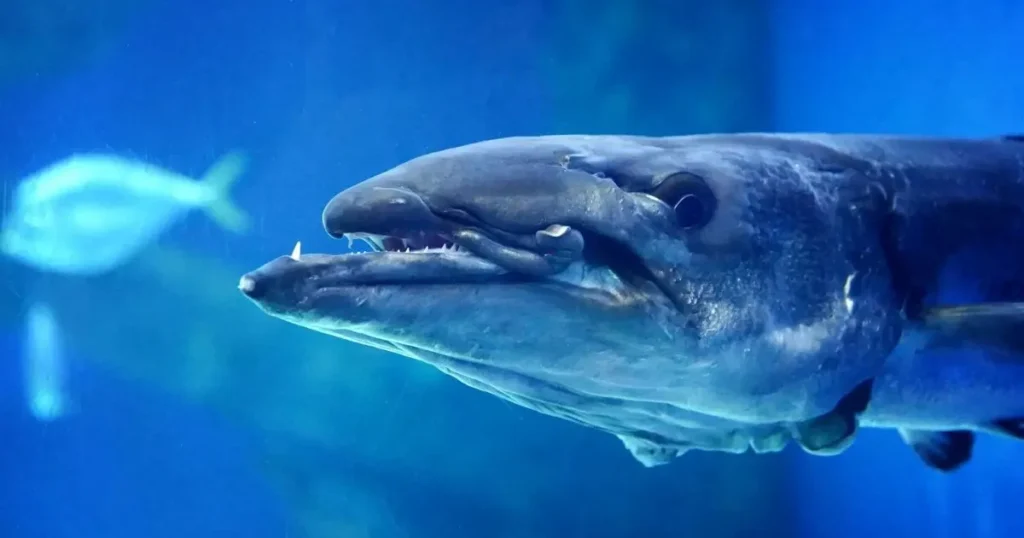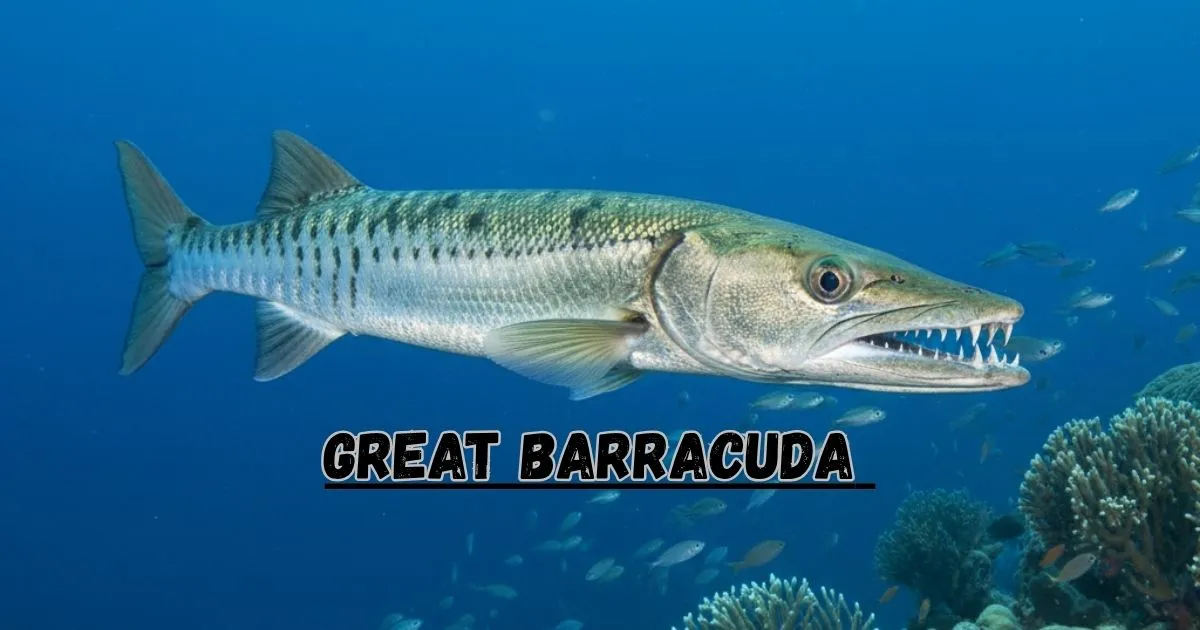Imagine a sleek, powerful fish that cuts through the water like a rocket that’s the great barracuda. Known scientifically as Sphyraena barracuda, this fish is one of the most fascinating predators in tropical and temperate oceans. The great barracuda is famous not just for its size but for its speed and impressive hunting skills. Measuring up to 10 feet long and weighing as much as 100 pounds, it’s like the sports car of the seas.
How to Identify a Great Barracuda?

Spotting a great barracuda is easier than you think! They have a long, torpedo shaped body that’s built for speed. Their color is often silver with dark bars or spots along the sides, which helps them blend in with the sunlight filtering through the water. But the most noticeable feature? Their fierce, sharp teeth that look like tiny daggers, perfect for gripping slippery prey. Keep an eye out for their big eyes and a mouth that looks like it’s ready to snap shut at any moment.
Where Do Great Barracudas Live? Habitat and Distribution
These speedy predators love warm waters. You’ll find great barracudas cruising through the Caribbean, the Atlantic, and even parts of the Pacific Ocean. They like to hang out near coral reefs, mangroves, and seagrass beds places packed with plenty of smaller fish to hunt. While they can swim in both shallow and deep waters, they prefer the coastal areas where life is buzzing. So, if you’re snorkeling or diving near reefs, you just might catch a glance of one darting through the water.
What Makes the Great Barracuda an Apex Predator?

Great barracudas sit at the top of their food chain meaning not many creatures are brave enough to hunt them. Their body is built for power and speed, allowing them to strike fast and hard. Those razor sharp teeth are no joke either; they grab hold of prey and make sure it can’t escape. They are opportunistic hunters, which means they’ll eat almost anything smaller than them, especially fish. Their hunting style? Ambush. They wait patiently and then burst forward like a torpedo, surprising their dinner.
Composition and Ontogenetic Changes in Diet
The barracuda doesn’t always eat the same thing. When they’re young, they mainly snack on smaller creatures like shrimp and tiny fish larvae. As they grow, their diet shifts dramatically. Adult barracudas prefer bigger fish, including grouper and snapper. Scientists call this diet change “ontogenetic,” which is a fancy word for how their eating habits evolve as they grow older. This change helps them survive by reducing competition for food within their own species.
Read More: Everything You Need to Know About Butterfly Betta Fish
Secrets behind the Great Barracuda’s Speed and Agility
What really makes the great barracuda stand out is its speed. This fish can swim up to 27 miles per hour! Imagine something faster than a car in a city. Their sleek body shape reduces drag, and their strong tail fin acts like a propeller, pushing them through water with explosive force. Plus, their muscles are built for quick bursts of power rather than long chases. This speed and agility make them deadly hunters, able to catch prey that other fish wouldn’t stand a chance against.
Camouflage and Hunting Strategies
You might think a big fish like the great barracuda would be easy to spot, but nature gave them a trick: camouflage. The dark stripes and spots on their silver bodies help them blend into the water’s shifting lights and shadows. This natural disguise lets them sneak up on prey without being noticed. When hunting, they use the element of surprise. They stay still or swim slowly, then explode forward in a flash, grabbing their food with precision before it can react.
The Science of the Barracuda’s Bite Force and Jaw Mechanics
Ever wondered how those sharp teeth actually work? The great barracuda’s bite is incredibly strong thanks to the design of its jaws and teeth. Their teeth are not just sharp; they point backward, so once they bite, the prey can’t easily escape. Their bite force is powerful enough to crush smaller bones and shells, helping them eat a variety of sea creatures. This combination of strength and precision is part of what makes them such effective hunters.
Human Interactions and How to Stay Safe
Great barracudas are curious, meaning they sometimes investigate divers or swimmers. But don’t worry they usually aren’t dangerous if you leave them alone. Most barracuda bites happen when people wear shiny jewelry or flash cameras underwater because the fish mistakes the reflections for small, shiny prey. If you’re diving or snorkeling, keep calm, avoid sudden movements, and don’t wear shiny objects. And definitely don’t try to feed them, as it encourages risky behavior.
Ecological Importance: Barracudas and Marine Biodiversity

Great barracudas play an important role in keeping the ocean healthy. As apex predators, they help control the population of smaller fish, which in turn affects the health of coral reefs and marine ecosystems. By preying on weaker or slower fish, they help maintain a balanced food web and prevent any single species from dominating the reef. In this way, the great barracuda helps support the vibrant underwater world.
Conservation Challenges Facing Great Barracuda Populations
Like many ocean creatures, great barracudas face threats. Overfishing and habitat destruction are the biggest risks. Since they live near reefs and coastal areas, pollution and coral damage can affect their homes and food sources. While they aren’t currently listed as endangered, monitoring their numbers is important to make sure they stay a part of our oceans. Conservation efforts focus on protecting their habitats and promoting responsible fishing practices.
Barracuda Behavior and Social Patterns
You might think barracudas are lone wolves of the sea, but they sometimes hang out in groups, especially when young. These groups, called schools, offer safety in numbers and make hunting more effective. However, adult barracudas are more solitary and territorial. They communicate with body movements and changes in swimming speed, which helps avoid unnecessary fights and coordinates hunting when needed.
Impact of Climate Change on Great Barracuda Habitats
The warming of ocean waters and increased acidification due to climate change affect many marine species, including the great barracuda. Coral reefs, their favorite habitats, are suffering from bleaching and damage, reducing shelter and food availability. Changes in water temperature can also shift their migration patterns as they seek cooler areas. Protecting our oceans from climate change is crucial for the survival of barracudas and countless other marine creatures.
Barracuda in Fishing: Techniques and Regulations
Fishing for great barracudas is popular in some regions due to their size and fighting ability. Sport fishers enjoy the challenge of catching these fast predators, but there are rules to follow. Many places have size limits or seasonal restrictions to avoid overfishing. Sustainable fishing helps ensure barracuda populations remain healthy for future generations. Always check local fishing regulations before heading out to fish for barracudas.
Understanding Barracuda Communication and Sensory Perception
Great barracudas have sharp senses that help them survive. They use a special system called the lateral line to feel vibrations and movements in the water, which guides them when hunting or avoiding danger. Their eyesight is excellent too, allowing them to spot prey from a distance. Scientists believe barracudas may communicate with each other through subtle body signals and swimming patterns, although this is still being studied.
Conclusion
In conclusion, the great barracuda stands out as one of the ocean’s most remarkable apex predators. With its sleek, torpedo shaped body, explosive speed, and razor sharp teeth, it is masterfully designed for swift and efficient hunting. Not only does it play a crucial role in maintaining the balance of marine ecosystems by controlling prey populations, but its feeding behaviors and sensory adaptations also showcase nature’s engineering at its finest. While generally not a threat to humans, respecting this powerful fish’s space is essential for safety.
FAQs
Are great barracudas dangerous to humans?
Great barracudas are curious but generally not aggressive toward humans. Most bites happen when the fish mistakes shiny objects like jewelry for prey. It’s best to keep calm and avoid wearing shiny items when diving or snorkeling near them.
What do great barracudas eat?
They mainly eat smaller fish such as herrings, sardines, and mullets, as well as squid and crustaceans. Young barracudas snack on small shrimp and larvae, gradually moving up to bigger fish as they grow.
How fast can a great barracuda swim?
Great barracudas can reach speeds up to 35 miles per hour. Their sleek bodies and strong tails allow them to burst quickly to catch prey by surprise.
Where do great barracudas live?
They live in warm tropical and subtropical oceans worldwide, especially near coral reefs, mangroves, and seagrass beds where food is abundant.
Can great barracudas be kept in home aquariums?
Because they grow large and need plenty of space and live food, great barracudas are not suitable for home aquariums. They are usually found only in public or research aquariums.
